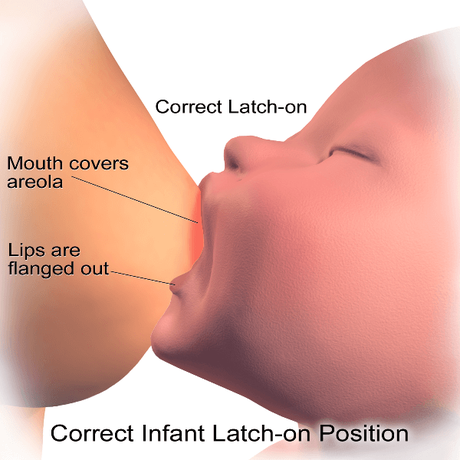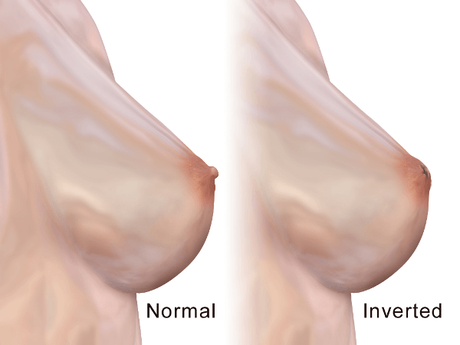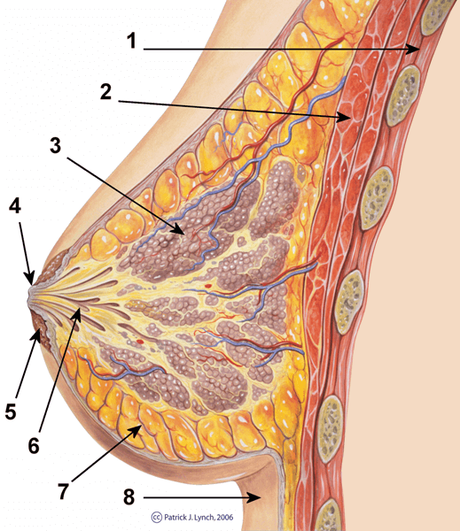"Breastfeeding is a mother's gift to herself, her baby and the earth." - Pamela K. Wiggins
Notice how the above quote talks about who's first in line to benefit from breastfeeding - the Mom! Yes, with World Breastfeeding Week, everyone is talking about the benefits of breast milk - antibodies, immunity, bonding, warmth etc. etc. While we wholeheartedly agree, there's a problem here - no one's talking about the Mom or her breastfeeding problems!
There are those who say that we are making too much of a fuss about something as natural as breastfeeding. Well, there's no doubt that breastfeeding is natural for the baby, but it is certainly not so for the mother. A mother needs to put an effort and suffer through quite a bit to make breastfeeding work. Unfortunately, most mothers are left to figure out breastfeeding on their own, and lactation counselors are still a rarity in India. And when you have extended relatives chiming in with their own bits of advice, it can drive the poor new Mom nuts!
In many cases, this leads to the Mom giving up completely, supplementing with formula or starting solids early - none of which are good for the baby's health. What we need is a more open conversation of a breastfeeding Mom's struggles. This is why we've put together a list of the most common breastfeeding problems faced by new Moms - along with solutions!

1. Painful latch
 Flickr: Aurimas_M
Flickr: Aurimas_M This is probably the biggest problem faced by new Moms and the most discouraging one as well! A study of new moms by the journal Pediatrics found that 54% Moms had latching problems and it was making them think of quitting altogether.

Simply putting your nipple in the baby's mouth does not ensure a proper latch. For a correct latch, not just the nipple, but a large part of the areola should be in the baby's mouth. The baby's mouth should be wide open at the start. Once attached, his lips should be curled outwards, and the nipple should be deep within his mouth. This ensures that the mother's nipple is not under undue pressure. It also enables the baby to suck and stimulate the glands under the areola to let out more milk.
Now even if you do everything right and the baby's latch is still suffering, he might have a lip or tongue tie. This needs to be evaluated by a doctor. A small surgical procedure can easily fix this and your baby can then latch on correctly.
The Breast Crawl
Babies are born with a natural instinct to breastfeed. This is visible in the 'breast crawl', which you can see in this video. When a newborn is placed on its mother's abdomen within an hour of birth, he finds his way to the breast all by himself, attracted by the scent. He roots around, sucks his thumb and eventually puts the nipple in his mouth and starts sucking. Amazing!
2. Engorged Breasts

In the few days following birth, Moms find that their breasts become huge as they fill with milk. While this is good news for the baby, hard and vein-y breasts are not fun for Mom! While pain is one issue, the nipples also get flattened out, making it hard for the baby to latch. Nothing is more distressing - your baby screaming in hunger even though your breasts are full of milk!
Large cabbage leaves are a traditional way to ease engorgement. You can also try massaging the breast a little, if it doesn't hurt too much. The best way is to use a breast pump to express a little milk to make the breast softer so baby can latch on successfully.
3. Mastitis

Mastitis is an infection of the breast tissue, caused by bacteria that transfers from the baby's mouth through a crack in skin. The symptoms resemble those of a fever, with high temperatures, shivering and aches. Since mastitis can get complicated if not dealt with promptly, it's best to see a doctor. Hot compresses may work for some but not for others, so medical advice is recommended.
The good part is that you can still continue feeding your child breast milk. Nursing is recommended, but if it is too painful, pump your milk. Feed the baby expressed milk till the infection tides over and you can nurse again.
4. Thrush
 Wikimedia Commons: By James Heilman, MD, CC BY-SA 3.0
Wikimedia Commons: By James Heilman, MD, CC BY-SA 3.0 Unlike mastitis, thrush is a fungal infection and can affect the baby's mouth and the mother's breast. A breastfed baby's mouth is the ideal place for thrush, which is transmitted to the mother's nipples. An itchy, burning sensation is a good indicator of thrush in the mother. Babies usually have a white, curd like coating on the tongue. Thrush requires anti-fungal treatment, or you and your baby could keep passing the infection to and fro. You can continue to breastfeed with thrush or opt to pump if it's too painful.
5. Undersupply

This is a problem that many women think they have, but only a few really do!! Studies show that only about 5% of mothers don't have enough milk for their baby. A great way to erase your worries is to weigh your baby right before and right after a feeding. Chances are you'll be pleasantly surprised!
Since a baby's sucking draws more milk than a pump, don't use the amount of expressed milk as a guideline. If your baby seems sleepy and satisfied after a meal and is growing well, there's nothing to worry about. However, if your baby is really not getting enough milk, you can try eating foods to boost your milk supply.
6. Oversupply
 Flickr: Goetter
Flickr: Goetter While not having enough milk is one problem, having too much of a good thing is also trouble! Too much milk is usually accompanied by a strong letdown. Due to this, the milk can spray out of the breast, and the baby can choke on it. It can also be inconvenient for the mother if it happens in public.
This problem usually resolves itself once a feeding routine sets in and the body makes the supply to match the demand. Till then, relieve some initial pressure by pumping, so baby can suck without choking. Let the baby feed from one breast completely and if she's full, let it be. Pump milk from the other breast to prevent engorgement. You can freeze this milk to use later or donate it to other mothers.
7. Leaky breasts

This is a real problem in public! A new Mom's hormones are designed to let down milk when her baby cries - the only problem is that this happens when any baby cries! Some Moms wake up in a puddle of their own milk, with the bed sheets a mess. Enough to discourage anyone!
The good news is that like most other problems, this disappears once the body settles into a proper milk production routine. Till then, make good use of quality breast pads. Try layering with a shawl or stole when you go out so that milk stains aren't visible. Feed your baby on demand so that your body adjusts to his needs sooner.
8. Inverted Nipples

Every woman's breast and nipples are different, but one condition that affects breastfeeding is that of inverted nipples. Here, the nipple is pointed inwards, rather than protruding outwards. It's not as big a problem as it seems, although some babies may have trouble getting a good latch. If the baby gets most of the areola into the mouth, then it's quite likely that the nipple's inversion doesn't affect feeding.
Other things you can try are using a nipple former or a nipple puller, which helps to draw out the nipple before a feeding. Alternatively, you can use a breast pump and pump a few times till the nipple comes out and then feed the baby. In case your baby is not feeding well at all and is losing weight, you may have to consult a doctor, and feed expressed milk in the meantime.
9. Blocked Ducts

The milk ducts help the milk reach the nipple for the baby to suck. The part in the image marked no. 6 are the milk ducts. In some cases the milk does not flow through the duct easily, causing a blockage which might appear as a lump on your breast or spots near your nipple. You may also experience pain along with the lumpiness. If left untreated, this can go on to become mastitits which can take longer to recover.
To avoid blocked milk ducts, be sure to wear a comfortable nursing bra in the right size. Your breasts are heavier, so ensure proper support, but keep away from wired styles. When feeding, feed on demand and let the baby drain one breast completely before starting on the other one.
10. Biting
 Flickr: Angelus
Flickr: Angelus Only a mother who's experienced a biting feeder knows the horror of it! Some Moms actually cry out in pain, and fear offering the breast the next time round. There are many things you can do to successfully breastfeed a biting baby, starting with identifying the reason for biting.
- Teething - If your baby is teething, then give her a teether or something cold and hard to chew on right before nursing so her gums aren't sore.
- Boredom - If your baby is biting at the end of nursing, then she's finished with her meal. Look out for signs that she's full and unlatch her before she gets a chance to bite.
- Distraction - If baby is overstimulated or distracted, she can't focus on nursing and may bite. If that's the case, calm her down first, and then offer the breast. If your older child is distracting you, your baby might be trying to draw your attention to her.
In any case, as soon as your baby bites, remove her from the breast for a while. Tell her gently that it's not good to bite (a lesson you'll be repeating through the toddler years). Soon your baby will get the message that when she bites, her meal gets interrupted and she'll stop.
11. Lazy Feeders
 Flickr: Viral Bus
Flickr: Viral Bus Breastfeeding Moms are often severely sleep deprived and a lazy feeder can make this torment worse! A lazy feeder is a baby who starts sucking aggressively and then just lies there with the nipple in her mouth or falls asleep. Removing the nipple from her mouth leads to a lot of crying and you're forced to put her to the breast again. As a result, the baby never gets her tummy full, leading to very frequent feeding sessions. This can drive Moms crazy as the baby always seems to be at the breast and they can't get a break!
One reason for this could be that your milk is coming in slowly. For this, massage your breasts prior to and even during feeding. In case of very young babies, they may be genuinely sleepy, so try to keep them awake by tickling their feet or stroking an ear. If your baby is not satisfied after multiple feedings at the breast, pump some milk and feed her. Resume the breast with the next feeding.
12. Nursing Strike
 Wikimedia Commons: Evan-Amos, Public Domain
Wikimedia Commons: Evan-Amos, Public Domain Can even babies go on strike? Fact is, they can! A nursing strike is simply when a baby suddenly refuses to breastfeed. The result is a hungry, angry baby and a Mom with breasts about to burst! A nursing strike could be due to a variety of reasons, and it's essential to understand the cause in order to find the solution.
- The baby bit you and you screamed in pain, scaring her
- The baby is teething and her gums are making her uncomfortable
- There has been a change in her life - Mom going back to work, new people at home, moving to a new place, travelling etc.
If your baby got scared by your scream lots of cuddling and quiet time will gradually get her back in the groove. This also works if there's been a lot happening around her. For a teething baby, give her a teething toy right before feeding, followed by a full breast. In the meantime, pump out your milk and feed her. If the strike goes beyond a few days, see your doctor; there may be an illness involved.
13. Breastfeeding Discreetly
 Flickr: Unicef UA
Flickr: Unicef UA Many Moms nurse for more than a year, and asking them to stay indoors for all that time isn't exactly reasonable! But every Mom wants to be able to nurse discreetly, especially in a country like ours where there are so many peeping Toms and ogling Oscars around. And if you're in a joint family, you might have assorted relatives entering your room all the time! For most Moms, the main concern isn't actually covering the breast; it's covering the upper chest and the stomach. These are the areas that are exposed when you either open the buttons in front or pull up a t-shirt or top. There are many ways to work around this:
- Get special nursing tops with strategically placed openings for feeding. They're often stylish and come in post partum sizes, but can be expensive. Make sure the zips and fastenings won't scratch your baby's face.
- Another tip many Moms have is to wear a long vest with a low neck inside and a regular top outside. To feed, just pull up the top, push down the vest and you're done! If the vest is not low enough, you can make slits in line with your nipples.
- Use a nursing cover that is worn like an apron and completely hides everything, even your baby! While nothing is visible in this case, it can make it more obvious that you're nursing. However, it might be good for the joint family situation!
A dupatta can also act as a good nursing cover, but remember that not all babies appreciate being covered. Be sure to do practice runs at home in front of a mirror so you know how it looks and your baby gets used to it. Else, you'll be stuck in a situation where your baby has pulled off the cover and you're left with a breast hanging out and a screaming baby who's refusing to latch on!
14. Breastfeeding Aversion
 Flickr: Jake Captive
Flickr: Jake Captive Breastfeeding is always glorified as this beautiful bonding experience that Moms love. But the truth is that not all Moms enjoy breastfeeding. Many actively hate it and do it only because of the health benefits or for financial reasons. This nursing aversion isn't to be confused with post partum depression. Here, the mother is perfectly fine and loves her baby but she doesn't like the act of breastfeeding. It makes her feel disgusted or gives her a 'creepy-crawly' feeling for as long as her nipple is in the baby's mouth.
In many cases this usually resolves itself once the Mom and baby get into a proper routine and a good pattern of demand and supply. For some Moms, this begins when they're pregnant and they're still feeding their toddler. Many think this is nature's way of getting the Mom to wean the toddler and prepare for the younger child. It can also be due to a hormone-related condition called Dysphoric Milk Ejection Reflex (D-MER).
No one is really sure why this happens, but you can take small steps to overcome these feelings. Keep yourself distracted with your phone, the TV or a funny parenting book. Ensure you're fed and hydrated. Get enough rest whenever possible. Think about weaning your older toddler. At times if you feel you can't take it, it's okay - just pump and feed. If it gets too overwhelming, it might be best to get professional help.
15. Older Children
 Flickr: Mothering Touch
Flickr: Mothering Touch In some ways, nursing older kids is better - they aren't dependent on breast milk and aren't attached to the breast 24×7. However, extended breastfeeding also has its own challenges. From kids who pull up your top in public to those who jump and nurse at the same time, there are many! Tandem breastfeeding a baby and toddler may look cute in pictures, but it requires a lot of effort and can be physically draining to a Mom.
It's a good idea to give your older child a few set times to feed during the day, with the remaining time devoted to your baby. Then set some nursing rules in place, such as no asking for 'Mummy's nummies' loudly in public, no pulling up/down Mommy's shirt and certainly no twiddling or pinching of the other nipple!
16. Intimacy & Relationships

This is a rather sticky topic that most people don't talk about - sex and intimacy after a baby. Breastfeeding and caring for a newborn is a 24×7 job, and a woman is left with little energy for anything else. For those who practice co-sleeping, there's always a chance that the baby'll wake up any minute and ask for a feed. Then there's the question of new Mom hormones which are all over the place for the initial months.
Many Moms also face emotional troubles. They are so into their 'mother' role that they can't think of themselves in their 'wife' role anymore. And if you're breastfeeding two or more kids at once, you may feel like your body's not yours anymore. All that skin to skin contact get a little too much and you don't want to be touched again.
The solution to this problem depends on each couple and their specific problems. Yet for most, it begins with adequate self care for the new Mom. Good food, enough rest and delegation of household responsibilities will make a woman feel much better. It's also a good idea to have a side bed for the baby to sleep undisturbed at night, once they're old enough. Most importantly, take things slow and realize that it all gets better eventually.
This World Breastfeeding Week, let's have open conversations about the good and bad of breastfeeding. This encourages Moms to find support and have a successful breastfeeding journey. Remember that having trouble with nursing does not make you a bad Mom - it makes you a great Mom because you're still trying!
Have you experienced any of these problems while breastfeeding? How did you cope with it? Main Image: Flickr Stream: Heroic Life